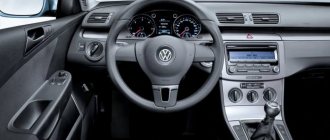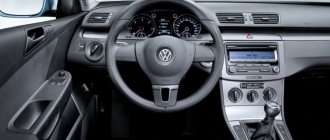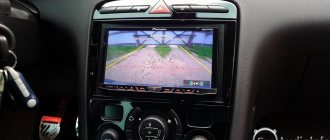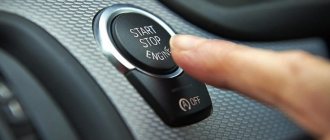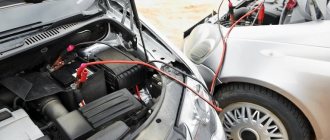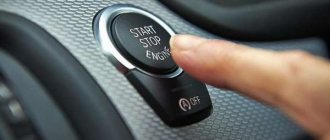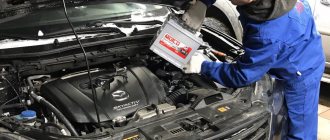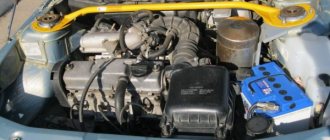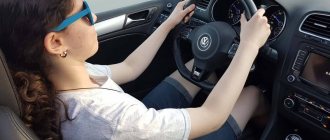Drivers note that every year the number of cars on city roads increases, and it becomes more difficult to find a place for long-term parking. Knowing how to park properly can help save time and make it possible to fit even in crowded parking lots. Novice motorists are afraid that they might hit nearby cars or damage their vehicle, so they often hire a driving instructor or watch video lessons to learn how to park correctly.
Parallel parking rules
One of the most important skills for a driver is the ability to parallel park a car in a confined space. Instructors often show two options: forward and backward.
Forward travel
To successfully park in front, the driver must follow the following rules:
- you need to move forward parallel to the row in which you need to park, remembering to turn on the right turn signal. You need to drive at a speed not exceeding 4 kilometers per hour;
- you need to remember that the distance between the right side of the car and the parked car should be 50 centimeters, it is better not to drive closer;
- when the middle pillar of the car reaches the front bumper of the car parked in the parking lot, you can turn the steering wheel to the right, at this time the vehicle will begin to drive into the right road pocket;
- the car will be located at approximately 45 degrees from the curb. At this moment, you need to turn the steering wheel all the way to the left. It turns out that the car will start to leave the parking space, while the rear of the car will move into the pocket.;
- after the car moves along the curb, the driver needs to align the steering wheel and drive the required distance to the car parked in front without moving the wheels. You should only move straight ahead.
Reverse
To use the method, you need to slow down, find a suitable place, and act according to the instructions:
- the driver needs to remember that to park he needs at least 1.5 meters from the length of his car. During the maneuver, the lights automatically turn on;
- after engaging reverse, you should carefully look in the left mirror and check if anyone is moving along the road in the same direction; if you can see an approaching car, then you should let it pass, and then return to the maneuver;
- you need to stop to the side of the parked car in front, the distance to the car should not exceed 70 centimeters;
- it is necessary to turn the steering wheel as far as possible towards the curb and move backward until the reflection of the headlight of a vehicle parked behind appears in the side mirror;
- the front part of the car appears on the road, and the rear part of the car goes deep into the pocket;
- the next step is to return the steering wheel to its original position and move forward until the wheels are at the intersection mark with the car in front;
- the driver should turn the steering wheel all the way away from the curb, after which the car begins to level;
- If the left headlight of the car behind is reflected in the left mirror, then the driver has sufficiently “hid” the vehicle in his pocket.
Perpendicular parking
The method is widely used in the parking lots of large supermarkets, train stations and airport parking lots. To park the car, the driver can move in reverse or forward, depending on the situation. If the next parking space is empty, it is better to move forward so that there is no risk of hitting someone else’s car with your right wing.
If cars are parked on each side of the parking space, then it is better to start driving in reverse, as shown in the diagram.
To easily use the perpendicular parking method, you should pay attention to the following tips:
- you must try to drive up in such a way that the rear left corner of the car in front is at the rear right wheel of your car;
- The distance between the side of the car and the vehicle in front should be approximately half a meter. It turns out that the driver needs to stand parallel to the car in front at a distance of 50 centimeters;
- You need to carefully back away, twisting the steering wheel to the right;
- After you can see the headlight of the car standing behind you in the left mirror, you need to put the steering wheel straight and continue to slowly move backwards;
- you need to not track the moment when the rear left wheel of the car aligns with the left headlight of a parked car behind. At this time, you need to turn the steering wheel all the way to the left and continue to back away slowly;
- When the position of the car is parallel to other vehicles, curbs and fences, then it is worth stopping. If necessary, the car can be straightened.
Sergey Nikolaenko Author of the traffic rules topic
Reversing is very dangerous. Despite the low speed, this maneuver can cause an accident. There is also a collision with other vehicles and the risk of hitting a pedestrian. When can they be fined, and in what cases does the driver risk being left without a license?
First of all, let me remind you that according to paragraph 8.12 of the Rules, reversing is possible only if it is safe and there is no interference for other road users. There is a separate ban on reversing at intersections. Please note that intersections do not include exits from adjacent areas that are not intended for through traffic (yards, residential areas, parking lots, gas stations, enterprises, etc.). That is, if you are moving along the road, and on the right, for example, is the entrance to the yard, then this is not an intersection, which means you can move in reverse.
In other words, if you are not sure that you will not hit anyone or that your actions will not force other drivers to stop, then you should not drive back.
It is clear that in life everything is a little more complicated. When leaving a parking lot, for example, we often force others to slow down. But this is normal, drivers understand perfectly well that it is difficult to reverse out of a parking space. Especially for inexperienced drivers. However, the Rules here are clear and inexorable. If you are not sure about the safety of a maneuver, ask others to help you. Moreover, such a restriction always makes the driver who was reversing guilty of an accident.
But these are only general provisions. There are also specific prohibitions. Thus, reversing is prohibited in those places where you cannot turn around (clause 8.11 of the Rules):
At pedestrian crossings; — in tunnels; — on bridges, overpasses, overpasses and under them; — at railway crossings; — in places with visibility of the road in at least one direction less than 100 m; — in places where route vehicles stop. In addition, reversing is prohibited on highways (clause 16.1 of the Rules).
There are no prohibitions on reversing on one-way streets in the Rules. Of course, you can move back while maintaining safety and to the nearest intersection or other restriction, which I wrote about above.
True, there are nuances. If you decide to drive backwards into a one-way street under a brick or drive backwards without making sure it’s safe, you may be punished under an “adult” charge. We are talking about Part 3 of Article 12.16 of the Code of Administrative Offenses of the Russian Federation “Driving in the opposite direction on a one-way road.” This is exactly what the Supreme Court reasoned in its decision No. 18 of October 24, 2006 (the changes in question were made to the document in February 2022).
In other cases, for improper reversing, the driver will be punished with a fine of 500 rubles (for violating clauses 8.11 and 8.12 of the Rules) or 2,500 rubles (for reversing on a highway).
There are, of course, sophisticated violations. So, some drivers manage to avoid traffic jams on the side of the road. At the same time, they are driving in reverse! Apparently they believe that driving on the side of the road is prohibited only during normal driving. But that's not true. The Rules clearly state that driving on the side of the road (sidewalks and pedestrian paths) is prohibited
And it doesn’t matter how you drive - in normal mode or backwards. The fines here are more serious than for general violations.
For the curb - 1500 rubles, for the sidewalk - 2000 rubles.
Novice drivers are concerned with the question of how to reverse out of a parking lot? To acquire the necessary skills, it is necessary to study all the ways to carry out this maneuver, starting with the simplest manipulations. First of all, you need to learn how to park correctly, use mirrors, etc.
Sometimes it happens that after parking the car, after a while the driver will find it difficult to leave the parking spot. The reason for this may be another car, whose owner parked it without caring about others or out of inexperience, so that it creates an obstacle to leaving. Let's consider these and other situations further.
Reverse parking
Reverse parking causes a lot of difficulties for novice motorists; parking between two parked cars causes a lot of problems. Before driving, you need to assess the situation on the road behind the car. When using a rearview mirror, you need to remember that the reflection distorts the actual distance to objects. During the maneuver, you can turn back, using a mirror in parallel. This algorithm will help reduce the risk of accidents. Experienced drivers advise you to act according to step-by-step instructions:
- you need to drive a little forward, as far as available space allows. You can move parallel to other cars in the parking lot;
- you should stop so that the trunk of the car is approximately 50 centimeters from the car in the parking lot, after which you need to turn the steering wheel to the side;
- before performing the maneuver, you need to look to see if there are people or cars nearby;
- you need to slowly back away while looking in the mirrors;
- when the car is in the parking space, you need to return the steering wheel to its original position and straighten the wheels.
When parking in reverse, the car is maneuverable. A driver who knows the rules and has basic parking skills can easily park the car in the chosen place. It is important to try to park the car only in a place that corresponds in size to the dimensions of the car. The car must be parked so that in the mirror next to the passenger seat you can see the reflection of the left edge of the car that is parked behind.
Dimensions
A rather banal thing: you need to learn to feel the dimensions of the car. What does it mean to feel? Grow nerve endings on the bumper? Develop a sixth sense like a bat? Everything is simpler and more prosaic: you need to learn to approximately determine the distance to an obstacle from the picture that you see in the windshield or rear window.
I won’t recommend the “contact parking” method based on the crack of the bumper of a neighboring car as a training method. But getting out of the car and assessing its position as you park is a good habit if you want to develop a sense of size. And in general, constant practice, as in the case of any other driving techniques, in this case is the best thing you can come up with.
A good helper in this case is parking sensors, and they are useful not only at the rear, but also at the front. Indeed, despite its apparent simplicity, determining the gap in front of the hood is just as problematic as behind the trunk - I judge, among other things, by my students, who all the time timidly stand up in their chairs, trying to see something behind the bumper. If the original configuration did not have parking sensors, and you are going to install them, it is better to install them both forward and backward - it will be calmer. And don’t save money, because there is nothing worse than a combination of “buggy” parking sensors and a mediocrely developed eye.
External cameras are also great helpers that will come in handy both from behind and from the front. It's great if you have all-round visibility, but it's now only found on very expensive cars. And even if you have a full set of sensors and cameras, you shouldn’t give up training your eye – you’ll need it!
Parking diagonally (herringbone)
Drivers call "herringbone" a parking method in which the vehicle is placed at an angle to the road. Many motorists like this method of parking the car due to the significant space savings. If car owners park their “iron horse” parallel to the highway, then only one car will be able to fit in the parking space. When motorists choose herringbone parking, 2-3 cars can fit in one space. The method prevents the car from being blocked by an unscrupulous driver who likes to stand close to a parked car.
The method is suitable for beginners who have recently gotten behind the wheel:
- When performing a maneuver, you need to take a lateral distance from the neighboring car of approximately 50 centimeters;
- when the side mirror of the car is next to the neighbor’s right taillight, you need to brake;
- you need to turn the steering wheel to the left and start to back away slowly;
- when the right headlight of the neighboring car appears in the mirror, you can start pressing on the brake;
- it is necessary to straighten the steering wheel and slowly back up, carefully twisting the steering wheel to the right;
- it is important to equalize the distance between neighboring cars, guided by the mirrors;
- The steering wheel must be placed straight.
Diagonal parking is permitted in adjacent areas, for example, in the courtyard of a residential building or in the parking lot in front of a store. You may find a parking sign on the road with an additional sign or with markings notifying drivers that it is possible to park in a herringbone pattern in this area. If there is a parking sign on the road without additional signs, then the driver needs to understand that he can only park parallel to this roadway. Violation of parking rules is punishable by a fine of 500 rubles.
Methods
There are certain ways to park in reverse, which have clear instructions and diagrams on how to do it. You can, of course, park the old fashioned way, when there were no different tricks, that is, you turn your head and drive back. This method is used by many who are not used to navigating by mirrors.
The main skill is acquired through practical application. If you recently bought a car, you can go to large sites in your free time and practice in different ways. If you immediately install parking sensors, it will be much easier, but you will not learn to park according to the schemes developed by specialists.
To learn how to properly reverse park a car, the mirrors must be adjusted so that they can see the area behind the car and on the sides. Everyone can have individual techniques. For example, some drivers lower the right mirror so that part of the rear wheel is visible. This is usually done if the rear has a high curb that could damage the bumper.
You need to develop the habit of parking correctly. Fines for illegal parking can be 1500, 3000, 5000 rubles. Also, in some cases, the car may be taken to an impound lot.
Common parking mistakes
Motorists who do not know how to park correctly make a number of mistakes:
- They have a poor sense of the dimensions of their car. You need to know and feel the size of your car, and understand whether there is enough space to maneuver. To “hone” skills you need to practice;
- the bumper hits the curbs. When parking, motorists often cannot correctly assess how high the obstacle is, and bumpers end up overhanging. To avoid damage when parallel parking, you need to perform a number of exercises;
- stand too far or too close. Many novice motorists are afraid of damaging their rims and park the car too far from the curb, thereby interfering with other road users. There are drivers who, on the contrary, stand too close to the sidewalk and damage their discs;
- put on the car on a slope. To prevent the car from rolling away, it is better not to leave the vehicle on the roadway with a slope, otherwise there is a high probability of getting into an accident;
- choosing a parking spot. Before parking your car, you need to evaluate the parking space and decide whether the car can fit in the parking space and whether the vehicle will interfere with other motorists.
In order not to make mistakes when parking, you need to think not only about yourself, but also about other drivers, whether the car is bothering them, and assess the risk of possible damage to your car.
How to choose a parking spot
Before choosing a parking place, the driver needs to find out where he can park and where there is a parking ban. It is worth remembering that parking near pedestrian crossings is prohibited. Also, don’t take up a handicapped seat for no reason. It is important to carefully inspect the site and find a place where there is minimal risk that someone will damage the car while driving in and out of the parking lot. It is important to follow the law and traffic rules, and not be afraid to learn new things.
When choosing a parking spot, you should pay attention to the visibility and adjust the side mirrors and the mirror located in the cabin properly. It is better for novice drivers not to go to places where cars in the parking lot resemble “sprats in a can”, and it is better to park the car a little further and feel confident behind the wheel. It is worth paying attention to the markings in the parking lot; they make it easier to park your car properly.
Note! Drivers often forget that a comfortable seating position plays a big role when parking. You shouldn’t lower your back too much and ride almost lying down. The instrument panel and steering wheel should not block your view.
Important rules for parking
- You cannot leave your car in the city where you want and how you want.
- To do this, there are certain places where you will not interfere with other road users and will not contradict traffic regulations.
- You need to get out of the car in such a way as not to damage it or anyone standing or passing nearby.
- You must always park your car on the right side on the side of the road or according to the pre-parking markings, and if there are none, on the edge of the roadway in one row.
- The easiest way to learn is on a specially prepared site. If there is none, you will need an empty street, a few empty cardboard boxes and free time. At first, leave more space between the boxes. If everything works out well, the space can be reduced.
What to do if you receive a fine for a sold car?
Park correctly!
Parking training exercises
To improve your parking skills, you can go to a race track and do a number of exercises:
- parallel parking: the driver must stand as close as possible to the edge of the area or to the cones without hitting the equipment with the right wheel;
- Reverse parking: the driver needs to drive the right side of the car as close as possible to the installed cone.
- leaving a parking space: the driver needs to leave the space without hitting the training markings;
- driving into the garage is one of the students’ least favorite exercises, but it is one of the most effective. After training, the driver will not only be able to drive into narrow spaces, but will also have a good feel for the dimensions of the car.
For training, you need a flat, paved area and equipment (you can use traffic cones and old tires as guides).
Before you start driving
How to reverse out of a parking lot without harming yourself and others? To begin with, you should map out your route. A beginner should think in advance about how to get out, how to taxi, where to turn. Next, you should look at both sides of the driveway (right and left), as well as the space behind the car. This will help ensure there is no traffic in the parking lot.
If the exit is clear, you are allowed to start moving. Be sure to turn on the appropriate turn signal.
In which gear should you leave the car in the parking lot (for manual transmission)
When parking a car with a manual transmission, a driver should adhere to the following rules:
- When parking on a downhill slope, you must put the vehicle in reverse gear and immediately apply the handbrake. If the car rolls forward, reverse gear will stop the process and prevent the vehicle from moving due to the fact that the crankshaft will rotate in the opposite direction;
- When parking, even on a slight incline, the driver needs to engage first gear and raise the handbrake.
The driver needs to remember that when leaving the car, it is better to turn the wheels in the opposite direction from the roadway, especially if there is no curb in this place.
Before performing the maneuver, you need to make a parking plan in your head, and if you plan to disembark passengers, then you need to leave a space up to the curb. It is important to take your time and remain calm, even if something doesn’t work out the first time.
